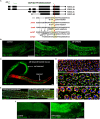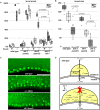ELLI-1, a novel germline protein, modulates RNAi activity and P-granule accumulation in Caenorhabditis elegans
- PMID: 28182654
- PMCID: PMC5325599
- DOI: 10.1371/journal.pgen.1006611
ELLI-1, a novel germline protein, modulates RNAi activity and P-granule accumulation in Caenorhabditis elegans
Abstract
Germ cells contain non-membrane bound cytoplasmic organelles that help maintain germline integrity. In C. elegans they are called P granules; without them, the germline undergoes partial masculinization and aberrant differentiation. One key P-granule component is the Argonaute CSR-1, a small-RNA binding protein that antagonizes accumulation of sperm-specific transcripts in developing oocytes and fine-tunes expression of proteins critical to early embryogenesis. Loss of CSR-1 complex components results in a very specific, enlarged P-granule phenotype. In a forward screen to identify mutants with abnormal P granules, ten alleles were recovered with a csr-1 P-granule phenotype, eight of which contain mutations in known components of the CSR-1 complex (csr-1, ego-1, ekl-1, and drh-3). The remaining two alleles are in a novel gene now called elli-1 (enlarged germline granules). ELLI-1 is first expressed in primordial germ cells during mid-embryogenesis, and continues to be expressed in the adult germline. While ELLI-1 forms cytoplasmic aggregates, they occasionally dock, but do not co-localize with P granules. Instead, the majority of ELLI-1 aggregates accumulate in the shared germline cytoplasm. In elli-1 mutants, several genes that promote RNAi and P-granule accumulation are upregulated, and embryonic lethality, sterility, and RNAi resistance in a hypomorphic drh-3 allele is enhanced, suggesting that ELLI-1 functions with CSR-1 to modulate RNAi activity, P-granule accumulation, and post-transcriptional expression in the germline.
Conflict of interest statement
The authors have declared that no competing interests exist.
Figures






References
-
- Smardon A, Spoerke JM, Stacey SC, Klein ME, Mackin N, Maine EM. EGO-1 is related to RNA-directed RNA polymerase and functions in germ-line development and RNA interference in C. elegans. Curr Biol. 2000. February 24;10(4):169–78. - PubMed
MeSH terms
Substances
Grants and funding
LinkOut - more resources
Full Text Sources
Other Literature Sources
Molecular Biology Databases

